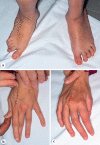Expanding Phenotype of SYT1-Related Neurodevelopmental Disorder: Case Report and Literature Review
- PMID: 38058756
- PMCID: PMC10697692
- DOI: 10.1159/000530586
Expanding Phenotype of SYT1-Related Neurodevelopmental Disorder: Case Report and Literature Review
Abstract
Introduction: Synaptotagmin 1 (SYT1), the predominant SYT isoform in the central nervous system, likely acts by promoting vesicle docking, deforming the plasma membrane via Ca2+-dependent membrane penetration.
Case presentation: Here, we describe a 21-year-old woman harboring a novel variant in the SYT1 gene, who presents with a complex phenotype, featuring severe intellectual disability, absent speech, behavioral abnormalities, motor stereotypies, dystonic posturing of her hands, a hyperkinetic movement disorder in her childhood, infantile hypotonia, sialorrhea, mild dysmorphic features, epilepsy, peculiar EEG findings, and severe scoliosis.
Discussion: Based on our case and literature review on the 22 previously described patients, we can confirm a complex neurodevelopmental disorder in which, unlike other synaptopathies, epilepsy is present in a subset of cases (including our patient: 5/23, 22%), although characteristic EEG changes are far more common (10/23, 43.5%). Our patient's age allows us to provide long-term follow-up data and thus better delineate the SYT1-related clinical phenotype.
Keywords: Dystonic posture; Epilepsy; Risperidone; SYT1; Valproic acid.
© 2023 S. Karger AG, Basel.
Conflict of interest statement
The authors have no conflicts of interest to declare.
Figures
References
LinkOut - more resources
Full Text Sources
Miscellaneous



